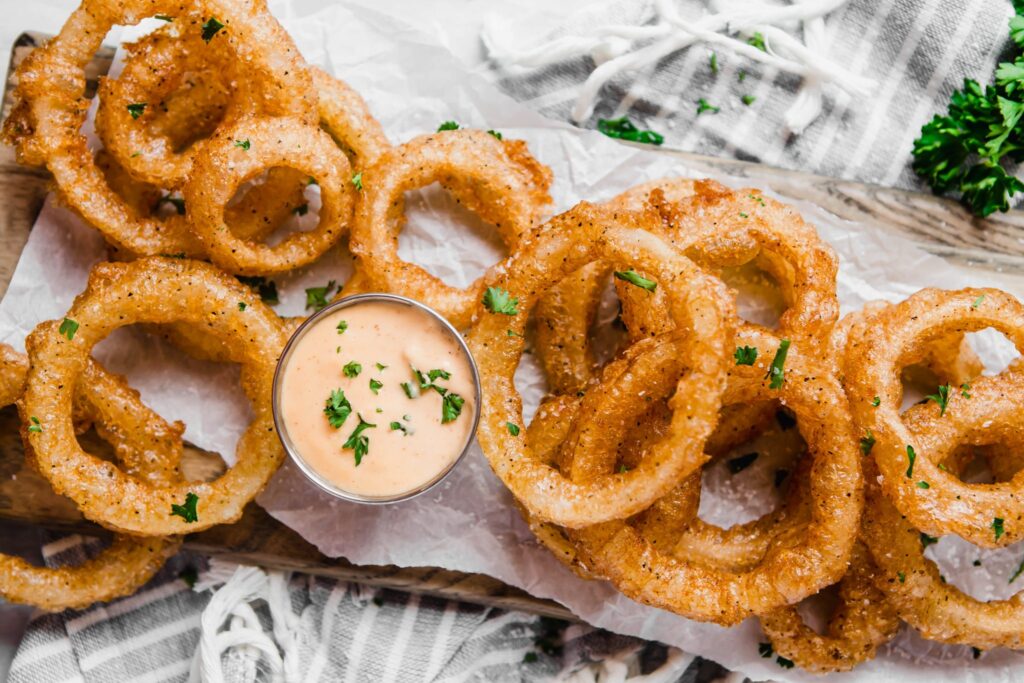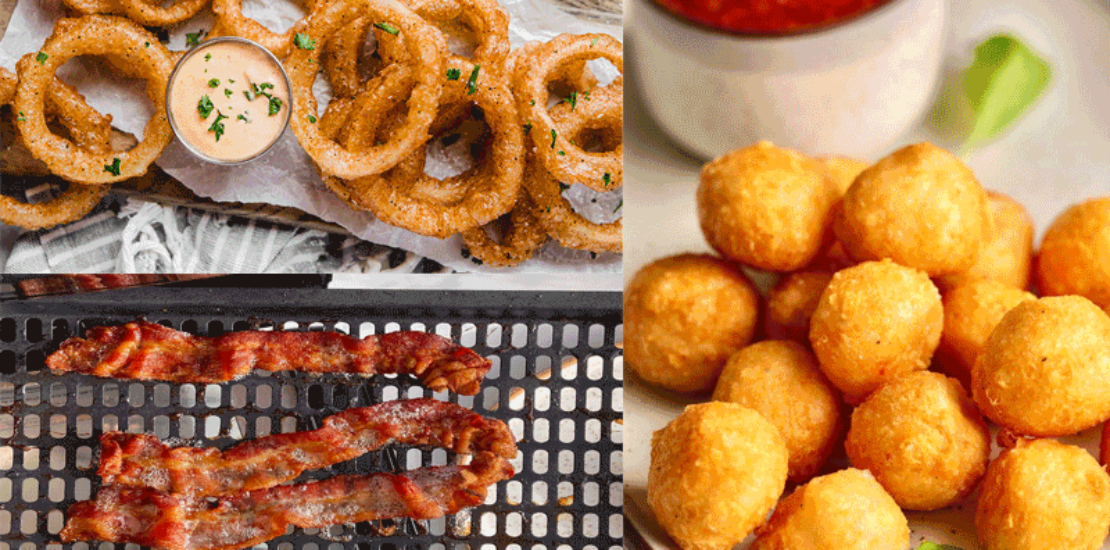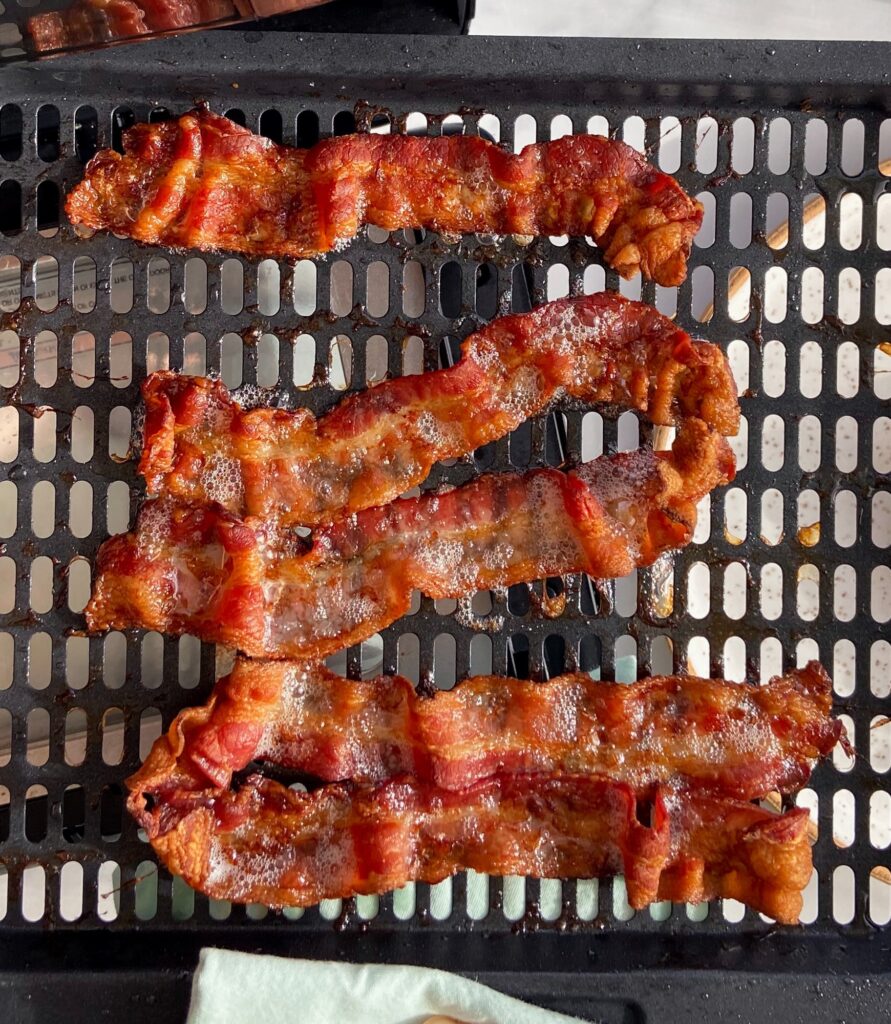products contain gluten: Onion Rings, Cheese Balls and Bacon Rashers.
Onion Rings, Cheese Balls and Bacon Rashers might sound like delicious party snacks, but they can be problematic
for people with gluten sensitivities or celiac disease. That’s because all three of these products contain gluten,
a protein found in wheat, barley and rye. For people with gluten sensitivities, even a small amount of gluten can
cause symptoms like abdominal pain, diarrhea and fatigue. For people with celiac disease, consuming gluten can
damage the lining of the small intestine, making it difficult to absorb nutrients. If you’re hosting a party and want
to make sure everyone can enjoy the snacks, there are a few gluten-free alternatives you can try.
Potato chips, pretzels and nuts are all great options that are naturally gluten-free.
Or, you could make your own onion rings, cheese balls and bacon rashers using gluten-free ingredients.
Most grocery stores now carry gluten-free flour, so it’s easy to find the ingredients you need.
With a little bit of effort, you can make sure everyone at your party enjoys the snacks – and doesn’t have to worry
about their gluten sensitivities.
-Many popular foods contain gluten, including onion rings, cheese balls, and bacon rashers.
-Gluten is a protein found in wheat, rye, and barley. It is what gives bread its chewy texture.
-For people with celiac disease, eating gluten can damage the lining of the small intestine, causing abdominal pain, diarrhea, and fatigue.
– gluten-sensitive people, consuming gluten can cause bloating, headache, and skin rash.
-There are many gluten
-free alternatives to these foods available on the market.
-With a little bit of research, you can find a gluten-free option that fits your taste.
-Many popular foods contain gluten, including onion rings, cheese balls, and bacon rashers.
Gluten is a type of protein found in wheat, barley, and rye. It is also found in many processed foods.
When people with celiac disease eat foods that contain gluten, they experience an immune reaction that damages
the lining of the small intestine. This can lead to a variety of symptoms, including diarrhea, abdominal pain, and
fatigue. There is no cure for celiac disease, but the symptoms can be managed by following a gluten-free diet.
This means avoiding all foods that contain gluten. Many popular foods contain gluten, including onion rings,
cheese balls, and bacon rashers. This can make it difficult for people with celiac disease to find safe and tasty foods
to eat. However, there are many gluten-free alternatives available.
With a little bit of creativity, it is possible to enjoy all of your favorite foods while staying safe and healthy.
-Gluten is a protein found in wheat, rye, and barley. It is what gives bread its chewy texture.

-Gluten is a protein found in wheat, rye, and barley. It is what gives bread its chewy texture.
While some people are able to eat gluten without any issues, others may experience an adverse reaction.
Symptoms of gluten intolerance can include bloating, abdominal pain, nausea, and diarrhea.
If you think you may be intolerant to gluten, it is important to speak to your doctor.
They can confirm whether you have a gluten intolerance or celiac disease, an autoimmune disorder that causes
damage to the small intestine. There are a few ways to manage a gluten intolerance.
The most obvious is to avoid eating foods that contain gluten.
This can be difficult, as gluten is found in many common foods like bread, pasta, and cereal.
There are, however, a growing number of gluten-free options available.
Another way to manage a gluten intolerance is to choose foods that are naturally gluten-free.
These include fruits, vegetables, meat, and fish. There are also a number of gluten-free grains, such as quinoa, rice,
and buckwheat. If you have celiac disease, you will need to avoid all foods that contain gluten.
This can be a challenge, as even trace amounts of gluten can trigger an immune response.
The only way to completely avoid gluten is to follow a strict gluten-free diet.
-For people with celiac disease, eating gluten can damage the lining of the small intestine, causing abdominal pain, diarrhea, and fatigue.

-For people with celiac disease, eating gluten can damage the lining of the small intestine, causing abdominal pain,
diarrhea, and fatigue. Symptoms of celiac disease vary from person to person, and can range from mild to severe.
For some people, even a small amount of gluten can trigger symptoms. Eating gluten-containing foods can cause
symptoms such as:
-abdominal pain -bloating -diarrhea -fatigue -headache -nausea -rash If you have celiac disease, it’s important to
avoid all foods that contain gluten. This can be a challenge, as gluten is found in many common foods, such as
bread, pasta, cereal, and baked goods. There are, however, a growing number of gluten-free options available.
With some careful label reading and a bit of trial and error, people with celiac disease can find a diet that works for
them and helps to ease their symptoms.
– gluten-sensitive people, consuming gluten can cause bloating, headache, and skin rash.
For gluten-sensitive people, consuming gluten can cause bloating, headache, and skin rash.
These symptoms can be uncomfortable and inconvenient, but they are usually not serious.
However, for people with celiac disease, consuming gluten can cause serious health problems.
Celiac disease is a condition that damage the lining of the small intestine.
This can lead to nutrient malabsorption, and can cause serious health problems if left untreated.
People with celiac disease must follow a strict gluten-free diet in order to stay healthy.
There are a variety of gluten-free products on the market, and more and more restaurants are offering gluten-free
options. With a little bit of planning, it is possible for people with celiac disease to enjoy a healthy, balanced diet.
-There are many gluten-free alternatives to these foods available on the market.
Onion rings, cheese balls and bacon rashers are all popular foods that contain gluten.
However, there are many gluten-free alternatives to these foods available on the market.
For example, onion rings can be made using gluten-free flour or breadcrumbs.
Cheese balls can be made with gluten-free cheese, and bacon rashers can be made with gluten-free bacon.
There are also many store-bought gluten-free alternatives to these foods available.
So, if you’re looking for gluten-free alternatives to popular foods like onion rings, cheese balls or bacon rashers,
there are plenty of options available to you.
-With a little bit of research, you can find a gluten-free option that fits your taste.
Looking for a gluten-free option for your next snack? No problem! A little bit of research can help you find the
perfect onion rings, cheese balls, or bacon rashers that fit your taste. If you’re craving something crunchy, onion
rings are a delicious option. Most restaurants fry their onion rings in a batter that contains wheat flour, but some
establishments offer a gluten-free version. To find out, just ask your server before you order. Cheese balls are
another great option for a crunchy snack. While traditional recipes for cheese balls call for breadcrumbs, there are
plenty of gluten-free substitutes out there. You can use crushed up corn chips, nuts, or even seeds to give your
cheese ball the perfect texture. And finally, bacon rashers are always a good choice when you’re looking for a salty
snack. Most bacon is cured with a sugar and salt solution, so it doesn’t usually contain gluten. However, it’s always
a good idea to check the ingredients list to be sure. So next time you’re looking for a gluten-free snack, don’t worry!
With a little bit of research, you can find something that satisfies your craving.
It is clear that there are many products on the market that contain gluten. Onion rings, cheese balls and bacon
rashers are just a few of the products that contain this protein. While some people may be able to eat these products
without any problems, others may experience serious health problems. For this reason, it is important to read
labels carefully and to consult with a health care provider if you have any questions or concerns.


